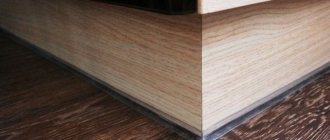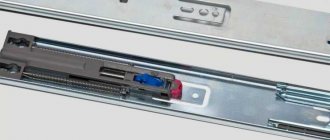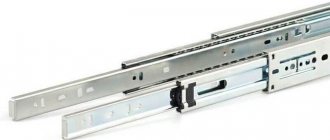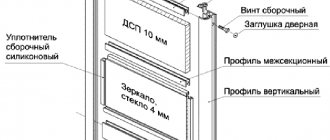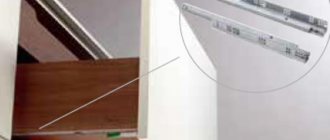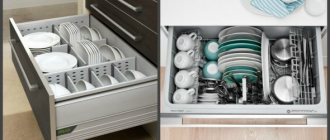Lockers for lockers and cupboards, sliding wardrobes
You can protect your child from the contents of bedside tables and cabinets using locking locks.
- Locks for cabinet doors and appliances can be adhesive-based and installed outside at a height inaccessible to the little explorer: they are suitable for refrigerators, cabinets and furniture.
- Wooden cabinets come with locking latches that must be secured from inside the cabinet with screws.
Security gates, safety doors for stairs and doorways, partitions
- Is there a need to block a young researcher’s access to the kitchen, balcony or stairs? We buy security gates. Material – wood, plastic or metal, mounting methods – your choice.
- Additionally, you can purchase panels that can be used to fence off a safe play area in the room.
Security gate PATROL FAST from Ikea, opening in both directions, costs 1,400 rubles , sliding gates made of beech - 2,000 rubles .
Sliding security gates from Safety 1st can be purchased for 2000-3500 rubles .
An accordion-folding lightweight portable safety barrier from Baby Dan and KidCo that changes width costs RUB 2,500-3,500 .
Multifunctional protective partitions from Baby Dan, Mothercare, KidCo cost about 8,000-10,000 rubles .
Features of child protection for drawers and cabinets, selection rules
Nowadays, childproofing on drawers and cabinets is a necessity, which helps to maintain the health of the child and the nerves of the parents. For this type of furniture, there is a huge number of different safety devices, which differ in shape, type of lock, design, and functionality.
The need to protect furniture
A small child is interested in everything that happens around him, so situations often arise that threaten the child’s health. The moment when children begin to crawl and walk is considered especially dangerous, since sharp edges and doors of furniture, sockets, and household appliances will pose a danger. Young children especially actively begin to explore the world from the contents of the closet and shelves. Some things can be removed or moved higher, but the sharp edges of tables, sofas, chairs, and drawers remain.
Even if you protect sharp furniture elements, the question arises about the contents of cabinets, cabinets, and drawers. The child can open the door, easily reach small objects, dangerous devices and valuables, and medicines. Therefore, it is important to take care of the difficulty of a child getting into the furniture.
To reduce the risk of injury to a child, caring parents resort to tricks: installing fences, restraints and bollards. Sometimes these devices are made independently, but a more reliable option is special products that can be purchased at hardware stores.
Types of blockers
There are several main types of blockers. The difference lies in the method of attaching the device to furniture and the features of their operation. There are Velcro and fixed supports.
Main types of door locks:
- locks the locks, which are fixed on the handles from the outside. The device securely closes the door leaves, which helps protect the contents from damage and the baby’s fingers from injury. The mechanism of the device is a plastic cord with notches that are fixed with a special attachment. The handles are tied with rope and closed with a “lock”. The advantage is that adults can easily open the mechanism, but children cannot;
- a universal lock connecting the door of a cabinet or chest of drawers to the body. The mechanism is a silicone strap, which is fastened with buckles on the sides. The advantage is the versatility of the fastening, since it can be easily used on drawers and doors where there are no handles at all;
- locking shock absorbers - devices of this type are made of elastic and at the same time durable materials: plastic, foam rubber, rubber, silicone. It does not close the door, but, on the contrary, does not allow it to open or close completely. Consequently, the child will not be able to stuff his fingers. A shock absorber is installed at the top of the door;
- locks for sliding doors, for example, for sliding wardrobes. Often the device is made of plastic and the mechanism completely replicates the design of the door, where the bar is fixed with a special buckle. It is impossible for a child to cope with the mechanism, but for an adult it is easy to open the door with such a lock;
- The internal locks are attached to self-tapping screws and are a pull-out design that will prevent the drawer of a dresser or chest of drawers from being opened. In addition, this detail does not attract too much attention from the child and does not spoil the appearance of the furniture.
It is better to choose blockers and other security elements that do not stand out against the background of the overall design of the room, so as not to attract undue attention to the baby. There are blockers for other needs: fastening plastic windows, limiting door locks. The main thing is to choose the right device for the appropriate door or drawer.
Adhesive based
Basically, all door and drawer blockers are designed for outdoor use. Attaching the device to furniture screws can ruin its appearance. Therefore, other methods of attaching blockers are used - an adhesive base.
This device consists of two “buttons” glued to a wooden body. A silicone or fabric strap is stretched between the buttons. After removing the elements, the glue is easily removed and leaves no traces on the surface.
Advantages of adhesive-based blockers:
- product availability;
- a huge number of different design solutions in color and design;
- fixing force;
- easy to remove, does not leave marks on the surface of the furniture;
- does not require special materials for fastening.
When choosing an adhesive-based device, be sure to pay attention to the integrity of the packaging and expiration dates. These conditions may affect the quality of the fastening.
Thanks to unique manufacturing technologies, you can choose a device in which the adhesive base will be completely environmentally friendly. The child should choose hypoallergenic materials.
For internal mounting
Drawers and cabinet doors often use internally mounted mechanisms. Thanks to the unique mounting method and functional characteristics, this type of bollard has many advantages.
The locks are applied to the internal fastening using adhesive tape with a special adhesive composition. Since the mounting location will not be visible from the inside, you can choose models with a screw fastening.
Advantages of internal mounting:
- the block does not spoil the appearance of the furniture;
- there is no risk of surface damage;
- does not attract children's attention;
- it is not necessary to select a product based on the inside of the room;
- wide range of functionality.
For bollards of this type, the main thing is strength, since they must withstand enormous loads. The design can be homogeneous and consist of two separate parts.
U and C shaped
Types of protection have features not only in the method of fastening. Some devices also vary in shape. Operating characteristics often depend on this. There are U- and C-shaped shock absorbers; they are not attached to frames and doors of this type - they are used mainly for interior doors.
The handles are U-shaped and C-shaped, so the furniture does not open. These devices latch securely and prevent child entry. These products are made of high quality plastic.
For adults, this latch is advantageous because it is very easy and quick to disassemble. There is no need to think about how to secure the block elements. The quick and easy way to assemble and disassemble is another advantage of this particular child restraint device.
Additional protection elements
Blockers can be secured not only with screws; other fastening options are also offered. They allow you to no less reliably protect everything that is stored inside the cabinet, without leaving any traces behind.
Even with a relatively small budget, it is quite possible to choose modern, convenient and reliable devices for protecting cabinets.
U and C shaped
Blockers are different:
- method of fastening;
- material;
- form.
Today, U- and C-shaped shock absorbers are available. Such models are put on two handles between each other and carefully fixed. A child cannot open such a lock. Most often they are made of high quality plastic. This type of protection can be installed quickly and easily in the hands of an adult, but for a child it will be an insurmountable obstacle.
These convenient and necessary protective mechanisms can be purchased in children's stores, as well as furniture or household goods stores.
For internal mounting
There are options that are attached using glue. There are models with internal locking. These options are convenient because you don’t need to select a shade to match the furniture. A large assortment of products allows you to choose the option with the most suitable functionality.
Such devices are widely represented in specialized online stores and on manufacturers’ websites.
Adhesive based
Blockers that are fixed with glue are very convenient and beneficial. On the one hand, they are quite firmly and tightly attached to the base of the furniture, or the place where it is attached, and on the other hand, if necessary, they can be removed without harming the surface of the product.
All of them are easily attached to furniture and just as easily, without marks or damage to surfaces, can be dismantled when they are no longer needed.
Important! Glue-based pads are safe for children, since special glue is used for such products. Therefore, such blockers are not only reliable, but also safe.
Door locks for children's safety at home
These devices will protect you from closing/opening interior doors, and therefore from getting your fingers pinched.
You can choose from a variety of purpose-specific accessories that best suit your needs.
- Bollards are installed between the door and the jamb on the hinge side to prevent them from closing.
- Other floor locks are installed under the door itself and prevent them from slamming shut.
- Third door locks for interior doors, on the contrary, prevent a child from opening them - they work like a lock and are attached to the door with reliable Velcro or small screws.
- A door lock allows you to lock the door in a desired position without being able to open or close the door.
- There are special locks on the door handles that prevent the doors from closing and prevent, for example, accidentally locking a child in the bathroom.
The cost of door locks varies from 75 to 350 rubles.
Attention! The door handle lock is selected as the handle lock. It should also be taken into account that all door locks should be closed and opened silently, so as not to wake the baby while he is sleeping.
Correct installation of a child lock
Installation of the device does not require much time, effort or special training. An adult, knowing the instructions, can install the product independently. The installation technology is as follows:
- The first step is to disinfect the surface where it will be installed.
- If the blocker is based on glue and purchased when it is cold outside, then it should be given time to warm up at room temperature. When cold Velcro is applied, it does not attach well, sticks, and the stopper will not work well.
- To speed up the process, you can warm up the attachment point with a hairdryer.
- Next, remove the protective paper from the patch.
- The blocker is attached tightly closed to the desired location.
- When the design of the lock requires fastening with screws, you need to use a screwdriver to screw them into the places where the lock is installed. The mechanism can be opened and unlocked by simultaneously pressing buttons on both sides.
- To ensure the safety of children, wardrobes are often equipped with a top mortise latch.
- Sliding locks of the C- and I-shaped design are attached to swing doors, where the handles on the doors are located nearby - at a distance of 2.5-21.5 cm. To open it, you need to unfasten the latch on one side of the lock.
The locking lock has become popular in many countries. For young child researchers, the blocker has become an insurmountable obstacle, and for parents it is a guarantee of peace of mind and confidence that the child is safe.
Safety of children in the home:
Voted over 294 times, average rating 4.4
Comments
Unfortunately, there are no comments or reviews yet, but you can leave your...
Add a comment Cancel reply
We recommend reading
Locks, Accessories Characteristics of overhead door handles not associated with the lock mechanism The choice of door handles is wide. Models are divided by type of work into...
Locks, Accessories A simple scheme for creating a combination lock for entrance doors with your own hands. The entrance door is installed so that strangers and unwanted ...
Locks, Fittings Description, purpose and installation of the strike plate for a door lock Regardless of the cost and quality of the door, maintain good condition...
Locks, Accessories We reveal the intricacies of opening a combination lock. Sometimes when entering a combination of numbers, the combination lock can...
Child locks on drawers and cabinets: protecting children from danger
Your baby was recently born and now he is actively inspecting every corner of the apartment.
The lock prevents hanging drawers from opening completely.
here it becomes necessary to think about the safety of the little explorer from unwanted objects and sharp edges, doors and boxes, to which the young know-it-all is attracted like a magnet.
Using a drawer and door protector can prevent unwanted opening by a child.
Fortunately, the modern market is full of all kinds of devices that can completely protect a child from possible injuries and dangers that await him at home.
To protect the contents of drawers from children, you must use a drawer lock.
These items will give parents more peace of mind and will also help them get rid of the extra work associated with putting things in lockers that were damaged by a child.
Prevents drawers and refrigerators from opening.
As soon as the baby begins to stand up or actively crawl around the house, parents need to think about the possible dangers that lurk within the walls of the apartment.
Prevents drawers from opening and bruising your child.
Cabinets and drawers with potentially dangerous objects attract a small child, and the doors themselves can injure him by pressing on his fingers.
Prevents drawers from opening and bruising your child.
To prevent children from opening cabinets, there are child locks for furniture that are resistant to children's hands.
Prevents unplanned opening of cabinets and appliances.
Such locks are inexpensive, so purchasing them turns out to be very advisable.
The lock prevents hanging drawers from opening completely.
The type of lock directly depends on the nature of the cabinet being locked and the method of opening it. After all, to protect a drawer from a thief, you need a completely different device than a sliding wardrobe with doors.
The universal Velcro seat belt protects your child from opening the refrigerator, toilet seat, desk drawers, etc.
Lockers for drawers
The most common and cheapest options are sold in children's departments of stores. They are quite easy to use, made of plastic and attached to furniture using special Velcro.
The lock is a universal security solution and fits a full range of kitchen appliances, cabinets and drawers.
It’s quite easy to peel them off; they won’t leave marks on the furniture. The mechanism is based on two elements. One element is attached to the edge of the box, and the other is attached to the wall.
When closing, you must click the lock, securing both parts. To open, you need to press the latch on both sides at once.
You can prevent your child from opening the closet door.
Different fastening models may have different types of opening: using a secret button, hook-and-eyes or a special key.
This security accessory can be used to restrict access to cabinets.
Handles with locks are more convenient and reliable to use, but they are more expensive and more difficult to install.
It will limit access and reliably protect your fidget from possible injuries and bruises.
Child protection on drawers and cabinets: how to make a lock with your own hands, protection from sharp corners of furniture
Anyone who has a child is constantly monitored and monitored to make sure they don't climb where they don't need to. But children are so curious that, first of all, their interest is piqued by something forbidden.
The closets and drawers where adults store their things are something that they won't leave alone and will be constantly drawn to. Therefore, protecting children on drawers and cabinets is not a whim of adults, but necessary precautions.
With their help, children will be healthy, parents will be calm, and there will be no unnecessary reasons for nerves.
An apartment for a small child is a huge and interesting world. Just starting to take its first steps, each little one stubbornly strives to explore this world.
Manufacturers offer a fairly large range of mechanisms that will block access to bedside tables, drawers and cabinets. There are types of devices that have the following differences:
- module;
- lock type;
- design;
- functionality.
Thus, each buyer can purchase the most suitable model for himself.
Types of child locks for furniture
There is a huge selection of blockers on the market. They differ:
- locking mechanism;
- features of use;
- functionality.
There are blocks that are attached with a special Velcro, that is, if necessary, they can be removed. There are also fixed versions of locks.
Drawers and cupboards of chests of drawers, shelves of closets in which things that are familiar and familiar to an adult are stored attract a child like a magnet.
To understand how to lock a closet from small children, you need to familiarize yourself with the options for locks and latches. The following models are distinguished:
- Locks with a mechanism for fastening the outer sides of the handles - such a mechanism securely connects two cabinet doors and helps protect all the contents in it from damage and falling into the hands of those for whom it is not intended. The tightness of the locking element will prevent children's fingers from getting between the two doors, which will avoid possible injuries. The mechanism consists of two parts: a plastic cord with notches and a special attachment; the handles are wrapped with laces, after which an attachment is used to fix the position of the lace. If an adult needs to take something, he can easily open the lock, but a child will not be able to do this.
- Universal locks - the essence of the work is that the mechanism reliably connects the furniture door with its body. The strap is made of silicone, which is attached with one side to the door and the other to the base. This model is quite functional, because it can also be used on furniture that does not have handles.
- Locking shock absorbers - for the manufacture of such a device, materials with increased elasticity and strength are used. It can be: silicone, foam rubber, rubber and others. The mechanism of this design differs from the previous ones in that it does not block the door, but simply prevents it from closing completely. Therefore, a small child will not get his fingers pinched even with a strong clap of his hands, because the obstacle will leave a gap of a certain thickness. This design is fixed in the upper part of the product.
- Sliding door lock: This model is great for sliding wardrobes. Most often, plastic is used to make such a mechanism; the model itself completely replicates the design of the door. This strip is put on the door, and a special buckle allows you to fix it in the desired position. This type of blocker is resistant to children's hands, but it is also not a hindrance for adults if necessary.
- Internal locks differ from previous models in that they are fixed not from the outside, but from the inside. The mechanism is fixed with self-tapping screws, and the product itself prevents the chest drawers from opening. Since attachment comes from within, it is not obvious and does not arouse further interest in the child. Another big plus is that this does not affect the condition of the furniture in any way.
When choosing blockers, you need to pay attention to the silent design so that they fit into the entire interior and do not attract unnecessary attention.
Without proper handling, coordination, and care skills, a young child can hurt himself or herself while exploring nearby corners of our furniture.
Homemade security features
Devices that prevent doors and cabinets from opening can be made with your own hands; for this you need to use your imagination. Parents seal the cabinets with duct tape or put rubber bands on the handles and hide the extension in a cardboard box.
If you make your own furniture safety devices, make sure they are secure before use.
Homemade option for protecting furniture corners using a tube and polyurethane tape:
Homemade option for protecting boxes:
What to look for when choosing
Child protection on drawers and cabinets must meet certain conditions. If the product does not meet quality conditions, the operational aspects of use may be disrupted. In addition, depending on the material and structure of the furniture, the appropriate types of blockers and protection are selected.
It is better to use proven brands from manufacturers. They can definitely guarantee the quality and safety of the product:
- For wooden furniture, internal fastening devices can be used. The fastening itself can be done using adhesive tape or small screws;
- for modern sliding wardrobes, mechanisms are used that are attached to the surface using adhesive tape;
- for sliding doors in sliding wardrobes it is better to choose sliding or band locks;
- in accordance with the age of the child, a mechanism with a certain quality of fastening and fixation is selected;
- Initially, you should pay attention to the manufacturer. There are fakes that are not characterized by quality;
- the material must be non-toxic, so it is worth studying the composition;
- Pay attention to the features of use, the simplicity of the latches and locks.
If the choice is not easy to make due to the complexity of the furniture design, then you should contact a professional. Sometimes you need the help of a specialist even in installing devices. Taking into account all the fastening features in the process of choosing a device, you can choose the best protection for furniture and protect your child from danger.
How to close cabinets and drawers from small children?
In the modern world, you can protect a child without damaging the furniture by cutting various locks and latches. Today there are many different devices that are attached to furniture and prevent the child from opening drawers and doors. They will be especially appreciated by parents who want to organize a children's corner in their room.
Depending on the type of furniture in the apartment and how the child tries to open them, the choice of child protection for the furniture depends. But it is important to remember that protection on sliding wardrobes will not work on wall cabinets and vice versa.
There are several types of furniture protection:
- It is possible to install mortise or rim locks. They are reliable, but the downside is that installation requires drilling several holes in the dresser or cabinet. Not everyone wants to ruin their furniture.
- There are also modern door and door locks. An adult can easily open them, but for a small child this is an almost impossible task. There are many types of such locks.
- Another delicate option: install new handles on the furniture - with built-in locks. No new openings are required on the facades.
- And, of course, we should not forget about the possibility of protection using old folk remedies - a rope passed through the cabinet handles, or tape glued to the drawers. However, it should be remembered that such methods are far from the most reliable. But if none of the above remedies can be used, then everything will be fine.
Locking devices for drawers
The most popular method of protection is special latches, one part of which is attached to the furniture frame using special Velcro, and the other half to the front of the drawer. These protective devices can be purchased at specialized children's stores. They are cheap and don't take much time to install. When the need for such fasteners passes, they can be easily removed and will not leave marks on the furniture.
There are many varieties of such latches, but their essence is that each of these locks has a main element that is fixed and remains motionless, and a counter element that acts in the same way as a lock.
you can install handles on furniture or, for example, on windows with a special built-in lock. But this method is a little more complicated than described above, since you will have to choose handles that will fit instead of handles installed on the furniture. After purchasing such a handle, it is installed on the drawer and simply locked.
Defense Mechanisms
The simplest devices for locking cabinet doors and cabinets can be made with your own hands. Our mothers and grandmothers used such simple methods using improvised means. Two adjacent door handles can be tied with a strong thick thread, rope or elastic band.
The disadvantage of this method is that the baby may well, over time, master the method of getting rid of such a “lock” and, with his own hands, open up access to the hidden depths of the furniture shelves. In addition, this is inconvenient for adults themselves, because the rope or elastic band will have to be removed every time you need to take something from the closet, and then re-attached to the handle.
Drawers or wardrobe doors can be blocked by gluing a strip of wide adhesive tape or insulating tape to their sliding surface. The disadvantages of this method are the same as those described above. In addition, the tape will leave sticky marks that are difficult to remove on furniture surfaces. You can curtain a chest of drawers or a cabinet with a large blanket or tablecloth.
The child will most likely see only a solid piece of matter and move on to more interesting things. This method is only suitable for very small and unintelligent children. It can be used as a temporary measure until more secure locking devices can be installed as soon as possible.
Sometimes furniture doors or drawers are equipped with mortise locks. Basically, such locks were often found in old furniture. In this case, you just need to find the key and do not forget to close the lock on the furniture with it after each use. Keep keys to cabinets and shelves out of the reach of small children. And of course, it is very undesirable to forget the storage location or lose the treasured key. In this case, taking the necessary items from bedside tables and chests of drawers will no longer be possible for an adult. However, modern furniture manufacturers do not often embed locks into drawers and doors.
If possible, it is better to take care of such furniture in advance by choosing the appropriate model or having it made to special order. It is not entirely advisable to embed such locks into existing furniture. The difficulty is choosing the lock itself.
The edge of the furniture is smoothed using protective tape: flat, angled or U-shaped. The material is rubber, which has a sticky side to secure the tape to the surface of furniture.


